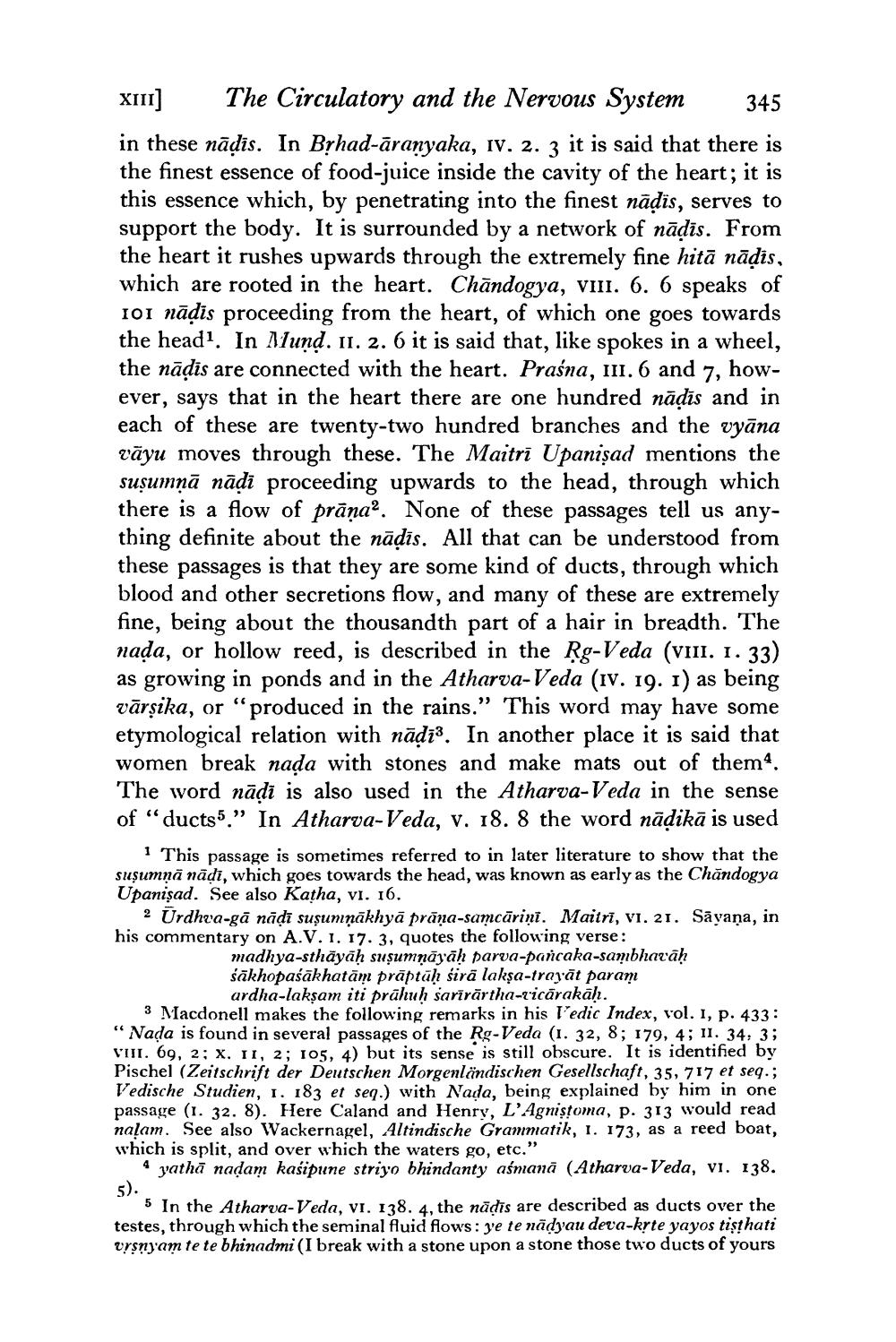________________
X11] The Circulatory and the Nervous System 345 in these nādīs. In Brhad-aranyaka, IV. 2. 3 it is said that there is the finest essence of food-juice inside the cavity of the heart; it is this essence which, by penetrating into the finest nāļis, serves to support the body. It is surrounded by a network of nādīs. From the heart it rushes upwards through the extremely fine hitā nāļis, which are rooted in the heart. Chăndogya, viII. 6. 6 speaks of 101 nādis proceeding from the heart, of which one goes towards the headl. In Nlund. 11. 2. 6 it is said that, like spokes in a wheel, the nādīs are connected with the heart. Prašna, 11. 6 and 7, however, says that in the heart there are one hundred nādīs and in each of these are twenty-two hundred branches and the vyāna vāyu moves through these. The Maitri Upanişad mentions the susumņā nādi proceeding upwards to the head, through which there is a flow of prāna?. None of these passages tell us anything definite about the nādīs. All that can be understood from these passages is that they are some kind of ducts, through which blood and other secretions flow, and many of these are extremely fine, being about the thousandth part of a hair in breadth. The nada, or hollow reed, is described in the Rg-Veda (VIII. 1. 33) as growing in ponds and in the Atharva-Veda (IV. 19. I) as being vārşika, or "produced in the rains.” This word may have some etymological relation with nādi. In another place it is said that women break nada with stones and make mats out of them4. The word nādi is also used in the Atharva-Veda in the sense of "ducts." In Atharva-Veda, v. 18. 8 the word nādikā is used
1 This passage is sometimes referred to in later literature to show that the suşumņā nādi, which goes towards the head, was known as early as the Chăndogya Upanişad. See also Katha, vi. 16.
2 Urdhra-gā nādī sușumiņākhyā prāņa-samcāriņi. Maitrī, vi. 21. Sāyaṇa, in his commentary on A.V.1. 17. 3, quotes the following verse:
madhya-sthāyāḥ suşumņāyāh parva-pancaka-sambhavāḥ sākhopaśākhatām prāptāḥ śirā lakşa-trajāt param
ardha-lakşam iti prāhuh sarīrārtha-Ticarakah. 3 Macdonell makes the following remarks in his l'edic Index, vol. I, p. 433: “Nada is found in several passages of the Rg-Veda (1. 32, 8; 179, 4; 11. 34, 3; VIL. 69, 2; X. II, 2; 105, 4) but its sense is still obscure. It is identified by Pischel (Zeitschrift der Deutschen Morgenländischen Gesellschaft, 35, 717 et seq.; V'edische Studien, 1. 183 et seq.) with Nada, being explained by him in one passage (1. 32. 8). Here Caland and Henry, L'Agnistoma, p. 313 would read nalam. See also Wackernagel, Altindische Grammatik, 1. 173, as a reed boat, which is split, and over which the waters go, etc."
yathā nadam kasipune striyo bhindanty aśmanā (Atharva-Veda, vi. 138. 5).
5 In the Atharva-Veda, vi. 138. 4, the nādīs are described as ducts over the testes, through which the seminal fluid flows: ye te nādyau deva-kyte yayos tişthati vrsnyam te te bhinadmi(I break with a stone upon a stone those two ducts of yours




